
Same-sex marriage isn’t anything new. Various forms of same-sex marriages have existed since Cicero first mentioned the marriage of the son of Curio the Elder around 50BC. The conversation in America took a big step forward on May 18, 1970 when Richard Baker and James McConnell applied to Hennepin (Minnesota) Court for a marriage license. Denied, the couple fought it to the U.S. Supreme Court. The court sided with Hennepin County.
On January 14, 2001, two same-sex marriages were performed in Ontario, Canada and the two couples involved become the first recipients of legal same-sex marriage in modern times. The discussion has continued in America and often the debate seems to take two-steps forward and one-step backward.
Proponents of same-sex marriage have been building their argument around civil rights. Opponents have been saying that legalization would be the end of life as we know it. The statistics, so far, are on the side of the supporters of same-sex marriage. Fears of rampant promiscuity just haven’t manifested.
In fact, one study has shown that same-sex couples have a lower — much lower — divorce rate than traditional male/female couples.
Questions About Same-Sex Marriage
Researchers have found the majority of LGBT adults are in committed relationships and have been for more than 10 years.
How Do Legal Limitations Affect LGBT Couples? The shame associated with a minority sexual identity is increased when the right to marry is denied. Chronic social stress and mental health problems have been identified in states where same-sex marriage is outlawed.
Why is Marriage Important? Marriage provides economic and social support to couples who are in committed relationships. Researchers have found that married men and women enjoy better physical and mental health than couples who are merely cohabiting.
So what are the facts about divorce rates among same-sex couples?
Divorce Rate
A study conducted by Lee Badgett, an economist at the University of Massachusetts Amherst, reports a same-sex divorce rate of roughly one percent per year. The figure is quite a bit lower than the divorce rate for traditional marriages. The study can be seen on Williams Institute’s website.
A brief analysis of the data seems to indicate that female couples are more likely to marry than male couples. Female couples account for a shade over half of the same-sex couples in America. The study also shows that the Supreme Court decision impacted the decision to marry with the number of same-sex couples nearly doubled in marriage equality states between 2012 and 2013.
Summary
A brief summary of what the study found:
- Almost 150,000 same-sex couples have either married or registered in civil unions or domestic partnerships.
- Couples are more likely to formalize their relationship legally when marriage is an option.
- Roughly two-thirds of married same-sex couples are lesbians and about 33 percent are gay men.
A small percentage of same-sex couples marry in comparison to straight couples.
In my experience, stemming from years of working with same-sex couples, the partners getting married are usually people who have been together as a couple for a number of years. This relational history has already given them time to weather the stormy, early years of the relationship. Also, LGBT couples are often consciously committed to being a family.
This desire to become a family unit and overcome existing hurdles helps dampen any desire to divorce quickly. Obviously, there are many couples whose relationships don’t last, but in general the LGBT couples I have worked with form strong emotional bonds and are committed to making their marriages work. Their commitment is bolstered by the fact that they often must travel across state lines to get married.
Despite the small amount of data and the resulting uncertainty of statistics, the trends uncovered in the report say a great deal about the world of same-sex marriage.
Related Articles:

Leave a Reply